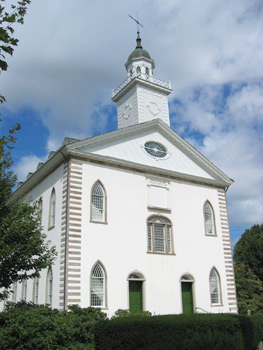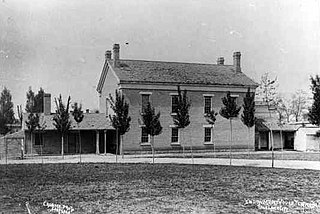
Maundy, or Washing of the Saints' Feet, Washing of the Feet, or Pedelavium or Pedilavium, is a religious rite observed by various Christian denominations. The word mandatum is the first word of the Latin Biblical quotation sung at the ceremony of the washing of the feet: "Mandatum novum do vobis ut diligatis invicem sicut dilexi vos", from the text of John 13:34 in the Vulgate. The ceremony commemorates the commandment of Christ that his disciples should emulate his loving humility in the washing of the feet. The medieval Latin term mandatum, came to apply to the rite of foot-washing on the Thursday preceding Easter Sunday, known in English as "Maundy Thursday" since at least 1530.

In Mormonism, the endowment is a two-part ordinance (ceremony) designed for participants to become kings, queens, priests, and priestesses in the afterlife. As part of the first ceremony, participants take part in a scripted reenactment of the Biblical creation and fall of Adam and Eve. The ceremony includes a symbolic washing and anointing, and receipt of a "new name" which they are not to reveal to others except at a certain part in the ceremony, and the receipt of the temple garment, which Mormons then are expected to wear under their clothing day and night throughout their life. Participants are taught symbolic gestures and passwords considered necessary to pass by angels guarding the way to heaven, and are instructed not to reveal them to others. As practiced today in the Church of Jesus Christ of Latter-day Saints, the endowment also consists of a series of covenants that participants make, such as a covenant of consecration to the LDS Church. All LDS Church members who choose to serve as missionaries or participate in a celestial marriage in a temple must first complete the first endowment ceremony.

In the Latter Day Saint movement, the term ordinance is used to refer to sacred rites and ceremonies that have spiritual and symbolic meanings and act as a means of conveying divine grace. Ordinances are physical acts which signify or symbolize an underlying spiritual act; for some ordinances, the spiritual act is the finalization of a covenant between the ordinance recipient and God.

In the Latter Day Saint movement the second anointing is the pinnacle ordinance of the temple and an extension of the endowment ceremony. Founder Joseph Smith taught that the function of the ordinance was to ensure salvation, guarantee exaltation, and confer godhood. In the ordinance, a participant is anointed as a "priest and king" or a "priestess and queen", and is sealed to the highest degree of salvation available in Mormon theology.

The Latter Day Saint movement is a religious movement within Christianity that arose during the Second Great Awakening in the early 19th century and that led to the set of doctrines, practices, and cultures called Mormonism, and to the existence of numerous Latter Day Saint churches. Its history is characterized by intense controversy and persecution in reaction to some of the movement's doctrines and practices and their relationship to mainstream Christianity. The purpose of this article is to give an overview of the different groups, beliefs, and denominations that began with the influence of Joseph Smith.

The Nauvoo Illinois Temple is the 113th dedicated temple of the Church of Jesus Christ of Latter-day Saints. It is the third such temple that has been built in Illinois.

The Kirtland Temple is the first temple built by adherents of the Latter Day Saint movement and is located in Kirtland, Ohio, United States. Designed by Joseph Smith, the founder and original leader of the movement, the architecture mixes the Federal, Greek Revival, and Gothic Revival architectural styles. The temple is currently owned and operated by the Community of Christ, formerly the Reorganized Church of Jesus Christ of Latter Day Saints. It has been a National Historic Landmark since 1969.

In the Latter Day Saint movement, a temple is a building dedicated to being a house of God and is reserved for special forms of worship. A temple differs from a church meetinghouse, which is used for weekly worship services. Temples have been a significant part of the Latter Day Saint movement since early in its inception. Today, temples are operated by several Latter Day Saint denominations. The most prolific builder of temples of the Latter Day Saint movement is the Church of Jesus Christ of Latter-day Saints. The LDS Church has 335 temples in various phases, which includes 188 dedicated temples, 52 under construction, and 95 others announced. Several others within the movement have built or attempted to build temples. The Community of Christ operates two temples in the United States, which are open to the public and are used for worship services, performances, and religious education. Other denominations with temples are the Apostolic United Brethren, the Church of Christ, the Fundamentalist Church of Jesus Christ of Latter-Day Saints, and the Righteous Branch of the Church of Jesus Christ of Latter-day Saints.
In temples of the Church of Jesus Christ of Latter-day Saints, an ordinance room is a room where the ceremony known as the Endowment is administered, as well as other ordinances such as Sealings. Some temples perform a progressive-style ordinance where patrons move from room to room, each room representing a progression of mankind: the Creation room, representing the Genesis creation story; the Garden room represents the Garden of Eden where Adam and Eve lived prior to the fall of man; the World room, where Adam and Eve lived after the fall; the Terrestrial room; and the Celestial room representing the Celestial Kingdom of God, or more commonly, heaven. There is also an additional ordinance room, the Sealing room, and at least one temple has a Holy of Holies. These two rooms are reserved for the administration of ordinances beyond the Endowment. The Holy of Holies is representative of that talked about when the temple is discussed in the bible.

The Endowment House was an early building used by the Church of Jesus Christ of Latter-day Saints to administer temple ordinances in Salt Lake City, Utah Territory. From the construction of the Council House in 1852, Salt Lake City's first public building, until the construction of the Endowment House, the members of the LDS Church used the top floor of the Council House for administering temple ordinances. When this arrangement proved impractical, Brigham Young directed Truman O. Angell, architect of the Salt Lake Temple, to design a temporary temple. Completed in 1855, the building was dedicated by Heber C. Kimball and came to be called the Endowment House after the endowment ceremonies that were conducted inside it.
In Mormonism, the oath of vengeance was part of the endowment ritual of the Church of Jesus Christ of Latter-day Saints. Participants swore an oath to pray for God to avenge the blood of prophets Joseph Smith and Hyrum Smith, who were assassinated in 1844. The oath was part of the ceremony from about 1845 until the early 1930s.

In Mormonism, a penalty is a specified punishment for breaking an oath of secrecy after receiving the Nauvoo endowment ceremony. Adherents promised they would submit to execution in specific ways should they reveal certain contents of the ceremony. In the ceremony participants each symbolically enacted three of the methods of their execution: throat slitting, heart removal, and disembowelment. These penalties were first instituted by Joseph Smith in 1842, and further developed by Brigham Young after Smith's death. The penalties were similar to oaths made as part of a particular rite of Freemasonry practiced in western New York at the time the endowment was developed. During the 20th century, the largest Mormon denomination, The Church of Jesus Christ of Latter-day Saints, gradually softened the graphic nature of their penalties, and in 1990, removed them altogether from its version of the ceremony. Other Mormon denominations continue to have the penalties as part of their temple oaths.

In the Church of Jesus Christ of Latter-day Saints, a temple is a building dedicated to be a House of the Lord. Temples are considered by church members to be the most sacred structures on earth.
In the theology of the Latter Day Saint movement, an endowment refers to a gift of "power from on high", typically associated with the ordinances performed in Latter Day Saint temples. The purpose and meaning of the endowment varied during the life of movement founder Joseph Smith. The term has referred to many such gifts of heavenly power, including the confirmation ritual, the institution of the High Priesthood in 1831, events and rituals occurring in the Kirtland Temple in the mid-1830s, and an elaborate ritual performed in the Nauvoo Temple in the 1840s.
In Mormonism, a prayer circle, also known as the true order of prayer, is a ritual established by Joseph Smith that some Mormons believe is a more potent method of prayer that can lead to receiving greater blessings and revelation from God. The ritual involves forming a circle of participants around a person who offers a prayer, usually at an altar in a temple. The members of the circle repeat the words of the prayer.

The following outline is provided as an overview of and a topical guide to the Church of Jesus Christ of Latter-day Saints.

The following outline is provided as an overview of and topical guide to the life and influence of Joseph Smith:
Exaltation is a belief in Mormonism that after death some people will reach the highest level of salvation in the celestial kingdom and eternally live in God's presence, continue as families, become gods, create worlds, and make spirit children over whom they will govern. In the largest Mormon denomination, the Church of Jesus Christ of Latter-day Saints, top leaders have taught God wants exaltation for all humankind and that humans are "gods in embryo". A verse in the LDS Church's canonized scripture states that those who are exalted will become gods, and a 1925 statement from the church's highest governing body said that "All men and women are in the similitude of the universal Father and Mother ... [and are] capable, by experience through ages and aeons, of evolving into a God."
In the Church of Jesus Christ of Latter-day Saints —Mormonism's largest denomination—there have been numerous alterations to temple ceremonies throughout the church's over 200-year history. Temples are not churches or meetinghouses designated for public weekly worship services, but rather are sacred places of worship open only to members in good standing with a recommendation from their leaders. LDS Church members perform rituals within temples. They are taught that temple ordinances are essential to achieving the faith's ultimate goal of exaltation after death for its members. They are also taught that a vast number of dead souls exist in a condition termed as spirit prison, and that a dead individual upon whom the temple ordinances are completed will have a chance to be freed of this imprisoning condition. In this framework ordinances are said to be completed on behalf of either the participant, or a dead individual the same sex as the participant.















